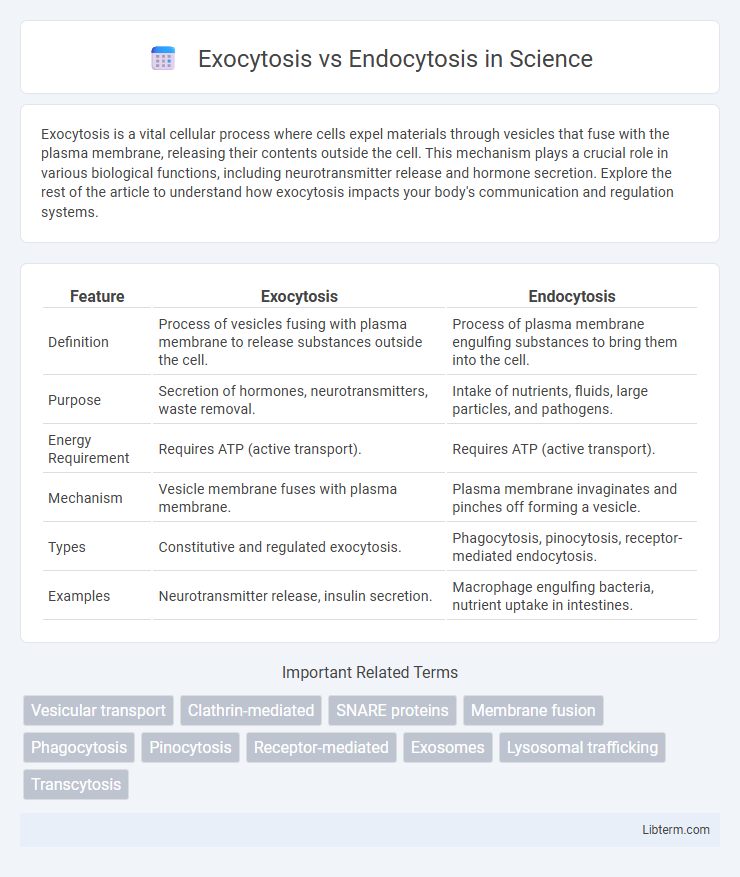Exocytosis is a vital cellular process where cells expel materials through vesicles that fuse with the plasma membrane, releasing their contents outside the cell. This mechanism plays a crucial role in various biological functions, including neurotransmitter release and hormone secretion. Explore the rest of the article to understand how exocytosis impacts your body's communication and regulation systems.
Table of Comparison
| Feature | Exocytosis | Endocytosis |
|---|---|---|
| Definition | Process of vesicles fusing with plasma membrane to release substances outside the cell. | Process of plasma membrane engulfing substances to bring them into the cell. |
| Purpose | Secretion of hormones, neurotransmitters, waste removal. | Intake of nutrients, fluids, large particles, and pathogens. |
| Energy Requirement | Requires ATP (active transport). | Requires ATP (active transport). |
| Mechanism | Vesicle membrane fuses with plasma membrane. | Plasma membrane invaginates and pinches off forming a vesicle. |
| Types | Constitutive and regulated exocytosis. | Phagocytosis, pinocytosis, receptor-mediated endocytosis. |
| Examples | Neurotransmitter release, insulin secretion. | Macrophage engulfing bacteria, nutrient uptake in intestines. |
Introduction to Exocytosis and Endocytosis
Exocytosis and endocytosis are essential cellular processes that regulate the movement of materials across the plasma membrane, maintaining cellular homeostasis. Exocytosis involves the fusion of vesicles with the plasma membrane to release substances such as neurotransmitters, hormones, and waste products into the extracellular space. Endocytosis allows cells to internalize extracellular molecules, including nutrients and signaling receptors, through membrane invagination forming vesicles for intracellular transport and processing.
Definitions and Core Concepts
Exocytosis is the cellular process where vesicles fuse with the plasma membrane to release substances outside the cell, facilitating secretion and membrane repair. Endocytosis involves the engulfing of external materials by the plasma membrane, forming vesicles that transport substances into the cell for nutrient uptake or pathogen removal. Both processes are vital for maintaining cellular homeostasis, enabling communication and material exchange between the cell and its environment.
Key Differences Between Exocytosis and Endocytosis
Exocytosis involves the transport of materials out of the cell via vesicles that fuse with the plasma membrane, whereas endocytosis is the process of engulfing external substances by invaginating the cell membrane to form vesicles inside the cell. Exocytosis primarily expels waste products and secretes molecules like neurotransmitters and hormones, while endocytosis mainly facilitates nutrient uptake, receptor internalization, and pathogen entry. Key differences include the direction of vesicle movement--exocytosis moves substances outward, endocytosis moves substances inward--and their roles in cellular communication and homeostasis.
Mechanisms of Exocytosis
Exocytosis involves the fusion of vesicles with the plasma membrane to release intracellular substances outside the cell, driven by SNARE proteins and calcium ion influx. This process enables the secretion of neurotransmitters, hormones, and waste products, maintaining cellular communication and homeostasis. In contrast, endocytosis internalizes extracellular materials through membrane invagination and vesicle formation, supporting nutrient uptake and receptor recycling.
Mechanisms of Endocytosis
Endocytosis involves the invagination of the plasma membrane to engulf extracellular materials, forming vesicles that transport substances into the cell. Key mechanisms include phagocytosis, where large particles are internalized through pseudopod extensions, and pinocytosis, which captures fluids and solutes via small vesicles. Receptor-mediated endocytosis uses specific ligand-receptor interactions to selectively uptake molecules, ensuring efficient cellular intake and regulation.
Types of Exocytosis and Endocytosis
Exocytosis primarily includes constitutive and regulated types, with constitutive exocytosis continuously transporting molecules like proteins and lipids to the cell membrane, while regulated exocytosis responds to specific signals, releasing neurotransmitters or hormones. Endocytosis comprises phagocytosis, pinocytosis, and receptor-mediated endocytosis, where phagocytosis engulfs large particles or cells, pinocytosis ingests extracellular fluid and solutes, and receptor-mediated endocytosis enables selective uptake of molecules via membrane receptors. Both processes are essential for maintaining cellular homeostasis, communication, and nutrient uptake.
Biological Significance and Functions
Exocytosis facilitates the transport of essential proteins, hormones, and waste products out of the cell, playing a critical role in neurotransmitter release and immune responses. Endocytosis enables cells to internalize nutrients, hormones, and pathogens, thereby regulating cellular uptake and maintaining homeostasis. Both processes are vital for cellular communication, nutrient acquisition, and the overall maintenance of cellular environment and signaling pathways.
Regulatory Factors and Triggers
Exocytosis is primarily regulated by calcium ion (Ca2+) concentrations and SNARE proteins that facilitate vesicle fusion with the plasma membrane, triggered by signals such as neurotransmitters or hormones. Endocytosis involves regulatory factors like clathrin, dynamin, and adaptor proteins, with triggers including ligand-receptor binding and membrane tension changes. Both processes are modulated by intracellular signaling pathways, ensuring precise control over vesicle trafficking and membrane composition.
Examples in Human Physiology
Exocytosis in human physiology includes the release of neurotransmitters from synaptic vesicles in neurons and the secretion of insulin by pancreatic beta cells. Endocytosis is exemplified by the uptake of cholesterol through low-density lipoprotein (LDL) receptor-mediated endocytosis in liver cells and the engulfment of pathogens by macrophages during immune responses. Both processes are vital for maintaining cellular communication, nutrient uptake, and immune function.
Summary and Comparative Analysis
Exocytosis expels materials from cells via vesicle fusion with the plasma membrane, facilitating secretion of proteins and waste, while endocytosis engulfs external substances through membrane invagination, enabling nutrient uptake and receptor-mediated internalization. Both processes are energy-dependent and involve dynamic cytoskeletal rearrangements, yet exocytosis primarily manages outward transport, whereas endocytosis handles inward trafficking. Key molecular players include SNARE proteins for exocytosis and clathrin-coated pits for endocytosis, highlighting distinct mechanisms tailored for cellular homeostasis and communication.
Exocytosis Infographic

 libterm.com
libterm.com